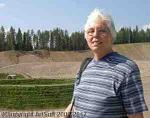Nancy Holt
Nancy Holt
Place: Worcester
Born: 1938
Death: 2014
Biography:
Nancy Holt was an American artist most known for her public sculpture, installation art and land art. Throughout her career, Holt also produced works in other media, including film, photography, and writing books and articles about art.
Nancy Holt was born in Worcester, Massachusetts. An only child, she spent a great deal of her childhood in New Jersey, where her father worked as a chemical engineer and her mother was a homemaker. She studied biology at Tufts University in Medford, Massachusetts. Three years after graduating, she married fellow environmental artist Robert Smithson in 1963.
In 2017 the Holt/Smithson Foundation was founded to continue the creative and investigative spirit of the artists Nancy Holt and Robert Smithson, who, over their careers, developed innovative methods of exploring our relationship with the planet, and expanded the limits of artistic practice. Through public service, the Foundation engages in programs that increase awareness of both artists’ creative legacies, continuing the transformation they brought to the world of art and ideas.
Holt began her artistic career as a photographer and as a video artist. In 1974, she collaborated with fellow artist Richard Serra on Boomerang, in which he videotaped her listening to her own voice echoing back into a pair of headphones after a time lag, as she described the disorienting experience.
Her involvement with photography and camera optics are thought to have influenced her later earthworks, which are “literally seeing devices, fixed points for tracking the positions of the sun, earth and stars.” Today Holt is most widely known for her large-scale environmental works, Sun Tunnels and Dark Star Park. However, she created site and time-specific environmental works in public places all over the world. Holt contributed to various publications, which have featured both her written articles and photographs. She also authored several books. Holt received five National Endowment for the Arts Fellowships, New York Creative Artist Fellowships, and a Guggenheim Fellowship. Holt along with Beverly Pepper was a recipient of the International Sculpture Center's 2013 Lifetime Achievement in Contemporary Sculpture Award. From 1995 to 2013, she worked and resided in Galisteo, New Mexico.
In 2008 Holt helped rally opposition to a plan for exploratory drilling near the site of Smithson’s Spiral Jetty at the Great Salt Lake in rural Utah. After Smithson’s death, Holt never remarried. Holt died in New York City on February 8, 2014 at the age of 75.
Holt is associated with earthworks or land art. Land art emerged in the 1960s, coinciding with a growing ecology movement in the United States, which asked people to become more aware of the negative impact they can have on the natural environment. Land art changed the way people thought of art; it took art out of the gallery or museum and into the natural landscape, the product of which were huge works engaging elements of the environment. Unlike much of the commercialized art during this time period, land art could not be bought or sold on the art market. Thus, it shifted the perspective of how people all over the world viewed art.
Land art was typically created in remote, uninhabited regions of the country, particularly the Southwest. Some attribute this popular location for land art to artists’ need to escape the turmoil in the United States during the 1960s and 70s by turning to the open, uncorrupted land of the West. Holt believed this artistic movement came about in the United States due to the vastness of the American landscape. As a result of earthworks not being easily accessible to the public, documentation in photographs, videos, drawings became imperative to their being seen. The first exhibit of contemporary land art was at the Virginia Dwan Gallery in New York in 1968. Other earth artists who emerged during this period include Robert Smithson, James Turrell, Walter De Maria, Michael Heizer, Dennis Oppenheim and Peter Hutchinson.
Holt’s works of art often deal with issues of how people perceive time and space. The various monumental works she created blend with and complement their environment. Works such as Hydra’s Head do not merely sit in their environments, but are made of the land, stand on it and are created to be harmonious with the land. The pools in this work are at the top of concrete tubes imbedded in the ground. The land already at the site surrounds these pools. They reflect the natural landscape, while not disturbing it. Holt thought about human scale in relation to the works she created. People can interact with the works and become more aware of space, of their own visual perception, and of the order of the universe. Holt’s works incorporate the passage of time and also function to keep time. For example, Annual Ring functions so that when sunlight falls through the hole in the dome and fits perfectly into a ring on the ground, it is solar noon on the summer solstice. At different times, the sun falls differently on the work and other holes in the dome align with celestial occurrences. Holt has said that she is concerned with making art that not only makes an impact visually, but is also functional and necessary in society, as seen in works like Sky Mound, which serves a dual function as a sculpture and park and it also generates alternative energy.
More...
Wikipedia link: Click Here


